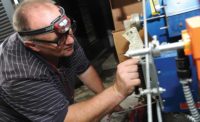Based on my experience as a draftsperson all the way up to facility management project manager, I have come to recognize that how a central air system is initially laid out on an architectural floor plan can determine whether it will be the cornerstone to a high-performance HVAC system or simply another conventional supply air system. I consider achieving high-performance HVAC systems an “art” (aka; the human skill of creativity, imagination, and practicality) that begins with a high-performance design initiative. Putting aside the energy efficient aspects of the system design, here is a practitioner’s steps that will address value engineering (before “VC, value cutting” occurs) and serviceability that will make the design efficient throughout the useful service life of this system.
Efficiency should start with quality control and, for me, this means have a time-tested designer’s checklist with categories that include the following.
Standardization
-
Minimize the number of transitions from one duct size to another (ask a sheet metal contractor how much sheet metal ends up on the shop floor as waste during the fabrication phase).
-
Minimize the number of terminal unit sizes. Ask a maintenance manager how many different size components need to be available in inventory.
-
Identify and use only the optimum duct fittings. Review ASHRAE 2013 Handbook, chapter 21 Duct Design.
Accessibility
-
Locate ceiling devices (e.g., dampers) out of the way of occupants. Use the reflected ceiling plan and the furniture layout drawings to determine optimum access to these devices for startup, air balancing, and routine maintenance.
-
Show terminal equipment access panel door swings and fan shaft, coil, and filter removal. Highlight on the design document access area where a maintenance person can get above the ceiling and/or next to equipment to work on the component without squeezing between pipes, conduit, etc.
-
Consider the eventual equipment removal when it reaches its useful service life.
Connection Efficiency
-
Review AMCA Standard guidelines for duct connection fans. Know the approximate static pressure drop from a bad fan inlet connection.
-
Review AMCA Standard guidelines for duct discharge from fans. Know the approximate static pressure drop from a bad fan outlet connection
-
Remember that once a fitting is installed, the fan energy waste is set for the life of the duct system.
Dampers & Louvers
-
Don’t assume the AHU manufacturer or the automatic control contractor will size the dampers. Make sure modulating dampers are sized to maintain controllability and not simply sized to fit the duct or air handling unit casing.
-
Don’t rely on the equipment manufacturer to determine the outdoor air damper and return air damper sizes and locations (read “AHU’s Must Be Manufactured Down South,” Tomorrow’s Environment column, May 2009).
-
Understand snow and rain can pass through an outdoor air louver no matter the louver intake velocity. Prevailing winds can blow snow and rain, so figure out how to minimize this building operator’s problem.
I have listed three suggestions for each category above, but there is far more to designing a duct system that will be cost efficient to install, operate, and maintain than these twelve suggestions.





